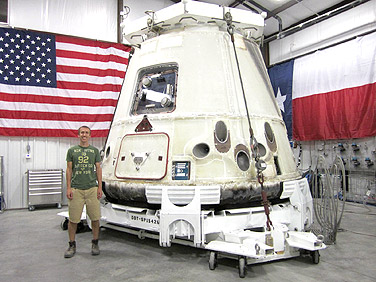News
UB grad working in space industry

UB alumnus Jared Kuhl stands beside SpaceX’s Dragon space capsule. Dragon made history by becoming the first commercial spacecraft to dock with the International Space Station. Photo: SpaceX
When the private company SpaceX launched its Dragon space capsule into orbit at the end of 2010, UB master’s student Jared Kuhl was watching from his computer in Buffalo. It was the first time a commercial firm successfully sent a vehicle into space and returned it to Earth.
“They did a live webcast of the launch,” remembers Kuhl, who was studying mechanical engineering at the time. “So I remember sitting in my office at UB and being like, ‘Oh god, that was awesome.”
Thrilled by the spectacle, Kuhl sent his resume to SpaceX. He landed a phone interview, and then was invited to tour the company’s California headquarters and its rocket development facility in Texas.
He got the job.
Kuhl says his time at UB prepared him for the “full-speed-ahead” work environment at SpaceX. He completed his BS in mechanical engineering here, and studied computational fluid dynamics as a graduate student under Paul DesJardin, professor of mechanical and aerospace engineering. He credits DesJardin with pushing students to work hard and tackle new, unforeseen problems.
“I think the most important thing that helps me that I learned at UB was how to attack something that I’ve never really seen before—how you sort of trace back a problem back to the engineering basics and figure out how to make something work,” Kuhl says.
In July 2011, soon after completing his studies, Kuhl moved to Texas to start work as a ground-support equipment engineer. In that role, he’s part of a team that designs and maintains rocket-engine testing facilities. He describes the atmosphere as fun and intense; he’ll often put in a 12-hour day, but the results are exciting to see.
“We test a rocket engine at least once a day out here, and there’s all types of different engines, so we can just walk right outside the office door and watch it any time it happens,” Kuhl says. “One of the first projects I worked on, we made a new test stand for an engine. We did all the up-front work of figuring out and designing the stand, and a couple months later we actually watched the engine fire and use all the systems that we had helped design and build.”
On days—or nights—when SpaceX has an important launch, employees gather in the cafeteria to follow the proceedings. Everyone feels like they’re part of something special, Kuhl said. When he was a boy, he and his father, a sixth-grade science teacher, used to look up at the night sky to watch the International Space Station passing overhead, a tiny blip of light drifting across a sea of stars.
So it was amazing to watch when SpaceX became the first company to deliver cargo to the space station earlier this year. As the aeronautics industry changes, with private companies playing a greater role in exploring space, there's no place that Kuhl would rather be.

Reader Comments